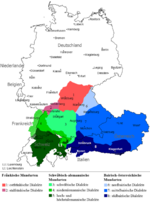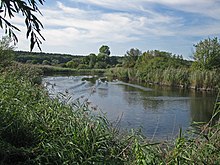Schweinfurt dialect
The dialect of Schweinfurt or Schweinfurt is used in Schweinfurt and the surrounding area. It belongs to the East Franconian dialect and here again to the subdialect of Lower East Franconia . The Schweinfurt relay line limits the area of the Schweinfurt dialect in the west.
Today the Schweinfurt dialect is almost meaningless within the core city , with a population of almost 50% migration background and 125 nationalities. But even earlier the dialect was less pronounced in the city than in the surrounding area. Historically, the Schweinfurt dialect was the language of the simpler people, the workers in the city and farmers in the area. Furthermore, the language of long-established originals to which figures from columns in the Schweinfurter Tagblatt were linked, such as s' Schorschle meent or the Rosl von der Keßlergass . The educated class spoke and speaks High German , with varying degrees of or hardly any Franconian sound coloring, as the Schweinfurt dialect, which sometimes sounds very hearty, is considered crude .
| Schweinfurt dialect | ||
|---|---|---|
|
Spoken in |
Bavaria | |
| Linguistic classification |
|
|
location
The area of the Schweinfurt dialect is relatively central in the East Franconian dialect area, which is marked on the right map in red and on the far right map with the writing Frängisch and here again Schweinfurt with Schwainfodd (Schweinfurterisch: Schweifert ). The western subdialect Lower East Franconian is shown here in yellowish to light brown surface colors. It extends between the northeastern border of Baden-Württemberg near Würzburg ( Wäzburch ) and the Rennsteig , the ridge of the Thuringian Forest . Schweinfurt lies in the middle of Lower East Franconia and, together with the Würzburg area on the southwestern edge, forms another subdialect zone. This is shown on the far right in the surface color ocher and has recently been referred to in public as "Meefränkisch" (also Meefränggisch ). Not to be confused with Mainfränkisch , which covers a much larger area.
Limits
Schweinfurt dialect
The Schweinfurt dialect is limited as follows:
- To the west of the Schweinfurt relay line and the identical Stum / Stube line (high German: Stube )
- In the north of the Schweinfurt relay line
- To the east of the grave field line
- In the south there is a smooth transition towards the more distant Ochsenfurt area
Bold font: Schweinfurt dialect
The Schweinfurt relay line runs close to the city and follows the western territorial border of the former imperial city of Schweinfurt. (see also: lower map)
Bamberg barrier
Not far behind the Grabfeld line, only 23 km east of Schweinfurt, is the Bamberg barrier, also known as the Steigerwald barrier or sometimes called the Schweinfurt Staffel . This runs in the Main Valley east of the Haßfurt district of Augsfeld am Landwehrgraben . It lies south of the Main between Knetzgau and Sand am Main, just 3 km to the east . It is the border to Bamberg , the so-called Mee / Ma line (high German: Main ). And above all the border between the two large East Franconian subdialacts, the Lower East Franconian ( Lower Franconia ) and Upper East Franconian ( Upper and Middle Franconia ) and on top of that the border between two South German names for the same profession, the Spengler / Flaschner line. It is also the western border of beer Franconia . This important dialect and cultural border runs through eastern Lower Franconia and is historically founded. It was the border between the Würzburg monastery to the west and the Bamberg monastery to the east .
While the border between the two administrative districts of Lower Franconia and Upper Franconia, 15 km further east, is meaningless in this regard. Which is why the (linguistic) dialect names Unterfränkisch or Unterostfränkisch neither here in the east nor in the west coincide with the administrative district of Lower Franconia, but are both more narrowly limited. The Landwehrgraben as a real symbol of a “language” and cultural border across a political district can be compared on a small scale with the Swiss Röstigraben .
Bold font: Schweinfurt dialect or job title in Schweinfurt
additional
Typical characteristics
The dialect differentiations are, like many other things in Franconia, very confusing. Which is why in Schweinfurt, in contrast to the Würzburg and Bamberg area, Franconian dialect names are negated: one does not speak Franconian of any kind, but Schweinfurt . A noticeable difference to the rest of Lower East Franconia is the plural formation with the ending lich , instead of li ; z. B. for high German little house not domestic but Häusli . Another typical feature is the n in the ending: z. B. Stollen (bread) - instead of Stolle , as at least in parts of the Würzburg area, with already slight Rhine-Franconian influences.
particularities
The Schweinfurt and Würzburg dialects are the only German dialects to give up fixed infinitive endings and are similar to English here .
The shortest form of “Do you have an egg left?” Occurs in the Schweinfurt dialect: Did you e Ä ü?
Typical for Schweinfurterisch is the sequence of many consonants in direct succession, e.g. B. six at Sennfldd ( Sennfeld ).
Food and drink play an important role in Schweinfurt, which is also reflected in the dialect, not far from the border between wine francs and beer francs - there are hardly more festivals anywhere else.
Error in the language atlas of Lower Franconia

Yellow: Reichsstadt Schweinfurt (Protestant).
Beige: Reichsdörfer (Protestant).
Braun: Imperial Knightships (Protestant).
Green: Counts of Schönborn (Catholic).
Red: German Order ( Brönnhof ).
Rosa: Hochstift Würzburg (Catholic) and various mandates
The linguistic atlas of Lower Franconia covers the linguistic geography of the dialects of Lower Franconia . It is part of the Bavarian language atlas company Bayerischer Sprachatlas . The research project has existed at the University of Würzburg since 1989 .
The ... Lich / ... li -line (eg. Homebody / Häusli ; see above) is incorrect in the Linguistic Atlas, north drawn from Schweinfurt, with the assignment of the city to the ending ... li , but during the ending ... is characteristic of the Schweinfurt dialect. In the map of the language atlas, Schweinfurt is in the southern Würzburg area and the border between it and the northern Würzburg area runs in a west-east direction through the northern Schweinfurt suburb area and through the middle of the former imperial city area, where the Schweinfurt dialect is of course spoken everywhere. In addition, this line runs across the north-south Schweinfurt relay line, which, however, limits the Schweinfurt dialect in the west and also follows the boundaries of the imperial city territory (see right).
When the Schweinfurts were assigned to the southern Würzburg area , the lack of a scientific lobby or university in Schweinfurt could have played a role or even the rivalry between the two cities.
Dictionary Schweinfurterisch – German
Roland Weger
Roland Weger created a dictionary of Schweinfurterisch German . A larger part of the list below was taken from him.
Words, idioms and nicknames
|
|
|
1 Analogous to basst scho in the Nuremberg dialect
2 Because of the profile of the dam
3 Because of the 230-meter-long three-dimensional glass roof
4 Because of the population center of Russian Germans
5 Because of the reddish exterior paint that was retained during the renovation in 2003 and 2006 due to the nickname
6 Because of the curtain wall Concrete façade, which during the renovation from 2010 u. a. was redesigned because of the nickname
literature
- Edgar Lösch: Mei Schweinfurt is mer darling and waiting - Schweinfurt and his local poets , Verlag für Fränkische Heimatforschung, 2006
- René Goscinny, Albert Uderzo, Gunther Schunk: Asterix dialect Lower Franconian IV: Asterix un di Wengert-Scheer , original title: Asterix and the golden sickle . Egmont publishing companies, Berlin 2011, ISBN 978-3770435142
Web links
- Lower Franconian Dialect Institute at the University of Würzburg
- Survey area linguistic atlas of Lower Franconia
- Poem in Schweinfurt dialect
Individual evidence
- ↑ BeuteBayern: Schweinfurt dialect and dictionary. Retrieved February 12, 2018 .
- ↑ mainpost.de: There is also racism in the multicultural city of Schweinfurt, March 21, 2019. Retrieved on April 3, 2019 .
- ^ Gunther Schunk, Hans-Dieter Wolf: Meefränggisch for Debben & Subber-Exberden . Königshausen & Neumann, 2010, ISBN 978-3-8260-4554-7 .
- ↑ a b c d e f g Linguistic Atlas of Lower Franconia. Retrieved February 12, 2018 .
- ↑ a b Lower Franconian Dialect Institute at the University of Würzburg: Territorial Relationships in Lower Franconia 1792. Retrieved on February 14, 2018 .
- ↑ a b Main Post: Where the Main is still the Maa. Retrieved February 14, 2018 .
- ^ BayernAtlas: Topographic map of the Augsfeld / Landwehrgraben area. Retrieved February 14, 2018 .
- ↑ Language Atlas of Lower Franconia / overview map of the dialects in Bavaria. Retrieved February 12, 2018 .
- ↑ deacademic.com. Retrieved February 12, 2018 .
- ↑ Main-Post: Würzburg / Schweinfurt: How will the region become even more successful? July 25, 2014, accessed February 15, 2018 .
- ^ Peter Hofmann: Schweinfurt Guide My Schweinfurt; Dictionary Schweinfurterisch - German. Retrieved March 27, 2016 .


